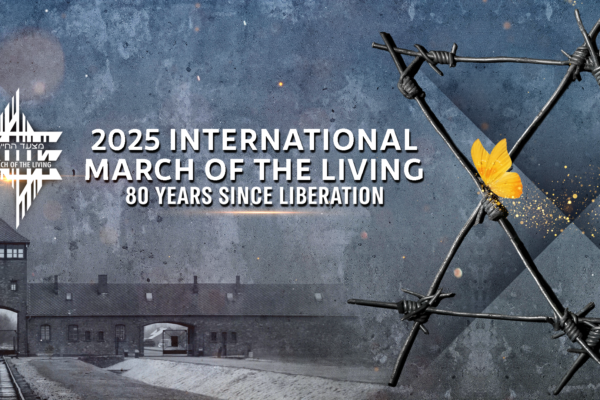Remarks by Eli Rubenstein
Director of Education, International March of the Living
International March of the Living Leadership Meeting
Thursday, March 28, 2024
Jewish Resilience in the Face of Adversity
Good morning, afternoon and evening to all:
This week, I received an email from a representative of ANU – The Museum of the Jewish People in Tel Aviv, (Formerly the Diaspora Museum), concerning a special program they are offering for educators about teaching resilience to young people in the wake of October 7th. And in the coming days, we will share with you information on this very meaningful program.
See:
https://drive.google.com/file/d/1ocfcslD2fG2BBNJVl3OK9Ul7nar8oDVD/view
https://drive.google.com/file/d/1wh5IfFLmKO1cncn4HBrXC6AxB1kiGZ7c/view
But as I was discussing this idea, I thought about how as we take our students on the 2024 March, and we dwell upon the events of the Holocaust and the most recent events in Israel, there is no question that many of our students will begin the March with an extraordinary feeling of vulnerability and fragility.
As they embark on this experience, they will understand all too well that the virus of antisemitism has once again begun to replicate out of control, and that we dare not be complacent – now or ever.
And thus we must also be careful in educating these young minds. We must not leave them despondent and bereft, despairing of the future of the Jewish people. We must also instill in them feelings of hope and resilience, in the face of these horrendous events, past and present.
So how do we do this? As I was contemplating this question, I was also attending an on line program that was reviewing one of Shai Agnon’s most famous stories called – בשעה אחת (In One Moment).
See: The Avrum Rosensweig Show with Rabbi Shlomo Gemara
For those of you unfamiliar with Shai Agnon, he is the only Israeli writer to win the Nobel Prize in Literature, which happened in 1966.
(As an aside, in a story told by Rabbi Jeffrey Saks, “Abba Eban, then foreign minister of Israel, thought that he ought to have a hand in crafting Agnon’s speech at the Nobel ceremony; after all, from a diplomatic standpoint, the Nobel Prize ceremony was an unprecedented opportunity to advance Israel’s diplomatic goals.
Agnon, however, took a different view of the matter. It is said that he retorted, “Tell Abba Eban that when he receives the Nobel Prize, he can write his own acceptance speech.”)
The title of the story , בשעה אחת, according to Rabbi Gemara, refers back to a famous story in the Talmud, about which I will conclude my short Devar Torah with.
This story is about many things – but most importantly it’s about the resilience of the Jewish people.
Avodah Zarah 18a
On their return, they found R. Hanina b. Teradion sitting and occupying himself with the Torah, publicly gathering assemblies, and keeping a scroll of the Law in his bosom. Straightaway they [the Romans] took hold of him, wrapped him in the Scroll of the Law, placed bundles of branches round him and set them on fire. They then brought tufts of wool, which they had soaked in water, and placed them over his heart, so that he should not expire quickly. His daughter exclaimed, ‘Father, that I should see you in this state!’ He replied, ‘If it were I alone being burnt it would have been a thing hard to bear; but now that I am burning together with the Scroll of the Law, He who will have regard for the plight of the Torah will also have regard for my plight.’
His disciples called out, ‘Rabbi, what seest thou?’ He answered them, ‘The parchments are being burnt but the letters are soaring on high.’14
גליון נשרפין ואותיות פורחות
‘Open then thy mouth’ [said they] ‘so that the fire enter into thee.’15 He replied, ‘Let Him who gave me [my soul] take it away, but no one should injure oneself.’ The Executioner16 then said to him, ‘Rabbi, if I raise the flame and take away the tufts of wool from over thy heart, will thou cause me to enter into the life to come?’ ‘Yes,’ he replied. ‘Then swear unto me’ [he urged]. He swore unto him. He thereupon raised the flame and removed the tufts of wool from over his heart, and his soul departed speedily. The Executioner then jumped and threw himself into the fire. And a batkol17 exclaimed: R. Hanina b. Teradion and the Executioner have been assigned to the world to come. When Rebbie (Yehuda Hanasi) heard it he wept and said: One may acquire eternal life in a single hour, another only after many years.
יש קונה עולמו בשעה אחת ויש קונה עולמו בכמה שנים
There is much to learn from this story, but the most important words to me are:
גליון נשרפין ואותיות פורחות
‘The parchments are being burnt but the letters are soaring on high”
“The paper burns, but the letters do not!”
There are so many parallels to the Holocaust in this story. How many Jews and how many Sefer Torahs were burned in the Holocaust? My own Aunt, Gabi Greenblatt, Aleha Hashalom, a survivor of Auschwitz, returned to her home of Debrecen after the war. Her entire family home was ransacked and pillaged from every valuable. Tellingly, the Sefer Torah was still there, but purposefully and gleefully torn into shreds and strewn all over the home, like confetti by the local Hungarian looters – all to add insult to injury.
But the messages from the story of Hannina Ben Tradyon and the stories from the Holocaust are the same.
“The paper burns but the letters fly away”. Force can never conquer spirit. The message of the Jewish people and our values will never be extinguished by brute force. Not then, not now, not ever.
In fact, in the wake of the October 7th attack, a massive Torah scroll writing project was initiated in Israel. “Thousands of Israeli Jews, including President Isaac Herzog, filled in letters on parchment to commemorate the 1,200 dead and raise awareness for the 138 hostages still held captive”, according to the Times of Israel. “One scroll is currently being written specifically for the synagogue of Kibbutz Be’eri, an epicenter of the October 7 massacre.”
(Note: It is a mitzvah for every Jew to write a Sefer Torah, or to appoint someone to write it for them. In 2005, David Greenblatt (Gaby Greenblatt’s son) commissioned the writing of a Sefer Torah in memory of his late father and in memory of all the Sefer Torahs lost in the Holocaust. The Torah was donated to Chabad at NYU.)
So as we embark on this year’s March of the Living, and share the stories of love and loss with our students – let us make sure the 2000 year old story of Hannina Ben Tradyon is one of the stories we share.
And let us remind our students that the light and message of Israel and the Jewish people will shine brightly forever and never be extinguished.








